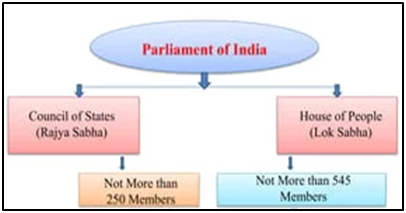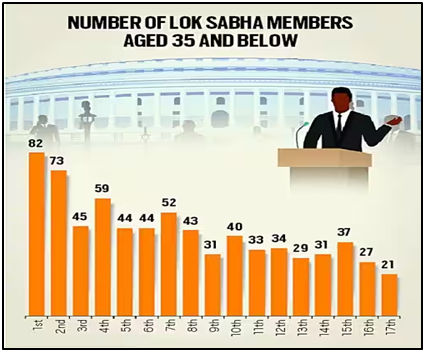Parliamentary Journey of 75 years: From Samvidhan Sabha-Achievements, Experiences, Memories and Learnings
Sept. 18, 2023
Why in News?
- The five-day special session of the Parliament of India (beginning Sept 18) is set to discuss “Parliamentary Journey of 75 years starting from Samvidhan Sabha - Achievements, Experiences, Memories and Learnings”.
- The article tries to trace the journey of Indian Parliament over these 75 years.
What’s in Today’s Article?
- A Brief History of the Parliament of India
- Performance, Operational Dynamics of the Indian Parliament
A Brief History of the Parliament of India:

- The Indian Parliament is the highest deliberative body and supreme representative institution of the largest working democracy in the world.
- The Constituent Assembly (Samvidhan Sabha) was the first representative body of the people of India.
- The two functions of the Constituent Assembly - Constitution-making and Legislation, were clearly separated with -
- The Constituent Assembly (Constituent body) commenced on 9 December 1946.
- While the Constituent Assembly (Legislative) commenced functioning from 17 November 1947.
- The Constitution was adopted on 26 November 1949 and it came into force on 26 January 1950.
- Immediately before the commencement of the Constitution, the Constituent Assembly became the Provisional Parliament of India and functioned as such until the 1st General Elections based on adult franchise were held in 1952.
- The institution of Parliament, since India’s Independence, is in a continuous state of evolution, adopting and adapting itself to the changing times and striving to actualise the aspirations of the people.
- It is imperative that the performance of Parliament, its operational dynamics and its varied activities should be communicated to the people.
- This will help in sustaining their trust and confidence in its efficacy as the people’s institution par excellence.
Performance, Operational Dynamics of the Indian Parliament:
- Age composition:

- The average age in the Lok Sabha has risen over the years from 46.5 years in the 1st Lok Sabha (1952-57) to 55 years in the 17th (2019-2023).
- Gender composition in the Parliament:
- Though the number of women candidates in the Parliament has risen, their share in the Lok Sabha ranks remains low.
- In the 1st Lok Sabha, there were 22 women MPs (4.41% of the total 489). The figure of 78 elected in the 2019 Lok Sabha elections is the highest ever, but it is still only 14.36% of the total.
- That makes it less than half of the 33% seats envisioned to be kept aside for women by the Women’s Reservation Bill.
- Sittings in the LS:
- Between 1952 and 1974, the Lok Sabha met for over 100 days a year each.
- The maximum number of days the Lok Sabha met in a year was in 1956, when it held 151 sittings; while its lowest was in Covid year 2020, when it met for 33
- The average number of minutes per day of sitting have also come down from 335 during the 1st Lok Sabha to 314 in 14th Lok Sabha (2004-2009).
- Bills passed:
- Not only are both Houses seeing fewer sittings, they are also passing fewer Bills. The highest number of Bills were cleared by the Lok Sabha and Rajya Sabha in 1976 (during the Emergency), when 118 Bills were passed.
- The lowest was in 2004, when the number stood at only 18. The second-lowest figure was in 2022, when 25 Bills were passed.
- Ordinances on the rise:
- With the Houses sitting for fewer days and passing fewer Bills, there has been an uptick in the ordinances promulgated by the Union government.
- From 1952 to 1965 (a period of stable Congress governments in power), the number was in single digits.
- From 1966 to the early 1980s (when the period of political uncertainty at the Centre began), it rose to double digits per year.
- This number again saw an increase during the 1990s (when there were coalition governments), but fell between 2002-2012.
- Since 2013, there has again been an uptick in the number of ordinances issued by the Centre.
- Time spent on questions:
- The time spent by the LS on questions has seen a decline.
- While the 1st Lok Sabha (1952-57) spent 15% of its total time on questions and answers, the figure fell to 11.42% during the 14th Lok Sabha (2004-2009).
- Voter’s turnout:
- Under active campaigns by the Election Commission to enrol voters, the electorate numbers have increased six-fold from 173.2 million in 1951 to 912 million in 2019.
- Women’s turnout has also been steadily increasing since 1962, the earliest year for which data is available.
- 62% of the male voters and 46.6% of the women electors turned out to vote in 1962.
- Women had left men behind, at 67.2% voting compared to 67%, by the time of the 2019 polls.
- The number of parties contesting Lok Sabha polls: Only 53 parties across India took part in the 1951 polls, while 673 (12 times increase) did so in 2019.
- Like the number of parties, the number of contestants is also on the rise from 1,874 in 1951 to 8,054 in 2019.
- Mandate: Of the 17 Lok Sabha elections held in the country so far, 10 have yielded a clear majority, while 7 have resulted in fractured mandates (1989, 1991, 1996, 1998, 1999, 2004 & 2009).
- 17th LS is first to go without Dy Speaker:
- In the history of Independent India, the 17th Lok Sabha is on course to becoming the first to not have a Deputy Speaker.
- As per The Rules of Procedure and Conduct of Business in Lok Sabha, the election of the Deputy Speaker shall be held on such date as the Speaker may fix.
- Usually, the Deputy Speaker is elected soon after the election of the Speaker.










